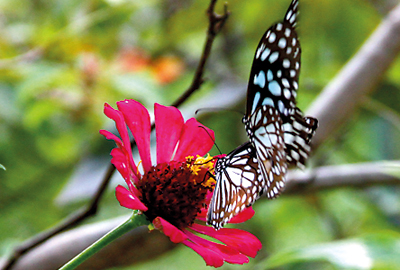The Butterfly Garden
View(s):By Aanya Wipulasena
Hello kids, today we are going to tell you about our visit to see some wondrous creatures of the earth. The Funday Times crew visited a butterfly garden set up in Moratuwa by Dilmah Conservation. As concrete buildings, vehicles emitting toxic gases and other modern creations started to invade nature these jewel winged little beings are in danger of extinction.

Common rose
Fortunately, in an effort to help these creatures to again spread their wings, Dilmah Conservation has come up with an awe-inspiring concept to build a butterfly garden in the middle of a concrete city. It was an amazing experience because we had never seen such a lot of colourful butterflies in one garden.
As it was early morning, we saw them busily fluttering their way from flower to flower which were covered with the morning dew, sparkling in the sun and creating a magical view.
“We were as astonished as you are now when we started work at our butterfly garden,” said Rajika Gamage when they saw our surprise. Mr. Gamage is the conservator of this butterfly garden. He has a wide knowledge of butterflies and he has also written books and articles on his studies of them.
He told us that when they first came up with the concept he had his fingers crossed because butterflies are least seen in crowded areas. “We started our work in 2011 as a research to see if we can breed butterflies in the middle of a busy city with concrete buildings and many kinds of pollution and were pretty much surprised when they started to breed in a short time period,” he said.
Now they have 41 different species in the garden out of the 245 species that are found in Sri Lanka. We have 26 species which are endemic to our country but at present none of them can be seen in this garden.
As we walked around the garden Mr. Gamage explained that 80% of the plants we find there are herbs and other plants we use in our day to day lives.
Butterflies breed in different plants, which are mostly native ones. Plants like Uguressa, Lovi, Kamaranga and Curry Leaves are some plants where butterflies breed on. Some have several breeding plants while most have only one.
Some butterflies choose poisonous plants as a survival technique to scare away insects, reptiles and birds. Another survival technique butterflies adopt is camouflage, where they blend into the environment, having colours which are bright and look poisonous such as black and red or black and yellow.
Mr. Gamage said that even though they adopt several survival techniques, the butterfly population in Sri Lanka is gradually decreasing. “The largest butterfly in Sri Lanka is the Sri Lanka Bird Wing. Before it was known as the Common Bird Wing but later the name was changed as they were not as common as they were before,” he said.
The Sri Lanka Bird Wing is black and yellow in colour and it has a wingspan of 150 – 180 mm. They are mostly seen in wet zone forests and it was also declared the National Butterfly under the Environment and Nature Resources Ministry.
So kids if we start now we can help our butterflies to survive. To start with Mr. Gamage said that we have to stop using pesticides and weedicides which kill these insects and scare them away from that area. “Then if we plant a native plant in the garden we can have a good start,” he said. Rose Periwinkle, French Marigold, Walidda plant and Star flower plants which are both flowering and butterfly breeding plants, fruit trees such as mango, custard apple trees, woodapple trees and soursop plants are some such plants.
To visit the butterfly garden you can contact Dilmah Conservation on 0714-113488 (Rajika).
Facts to remember:
- All butterflies and moths belong to the biological order Lepidoptera.
- Moths are mostly dull in colour.
- The butterflies breed in good climates so that their eggs wont be destroyed.
- Butterflies go through a life cycle: Butterfly – Eggs – Caterpillar – Chrysalis – Butterfly again.
Follow @timesonlinelk
comments powered by Disqus
















